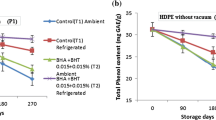Abstract
Kernel chemical composition and fatty acids profile of three walnut cultivars (Toyserkan, Chaboksar and Karaj) was analyzed. Some physicochemical properties, total phenolics content (TPC), ortho-diphenols content (ODC) and total tocopherol concentration (TTC) of extracted oils from the walnuts were also determined. The antioxidant activity of oil was measured by 1,1-diphenyl-2-picrylhydrazyl (DPPH) radical scavenging capacity and β-carotene bleaching assays. The analysis of chemical composition revealed that protein and dietary fiber was highest in Toyserkan cultivar. Phosphorus was the most abundant element in the walnut kernels, followed by potassium, magnesium and calcium. The linoleic acid and linolenic contents ranged from 50.15% to 51.36% and 10.48% to 12.04%, respectively. Also, the results demonstrated that acid value, saponification value and viscosity of extracted oil had significantly varied between all cultivars. The extracted oil from Chaboksar cultivar illustrated more hydro peroxides and secondary products than those obtained from other cultivars. A positive correlation was found between Rancimat values and oleic acid content (r = 0.60), but considerably negative correlation with TTC (r = −0.81) and TPC (r = −0.92). The relationship between percentage of remaining DPPH radical and β-carotene of walnut oils showed high correlation among three selected cultivars (r = −0.94 to −0.97).




Similar content being viewed by others
References
Adeeko KA, Ajibola OO (1990) Processing factors affecting yield and quality of mechanically expressed groundnut oil. J Agric Eng Res 45(1):31–43
AOAC (1990) Official methods of analysis. Association Official Analytical Chemists, Washington
AOCS (1998) Official methods and recommended practices of the American Oil Chemists’ Society. AOCS, USA
Aparicio R, Roda L, Albi MA, Gutierrez F (1999) Effect of various compounds on virgin olive oil stability measured by Rancimat. J Agr Food Chem 47:4150–4155
Arranz S, Cert R, Pérez-Jiménez J, Cert A, Saura-Calixto F (2008) Comparison between free radical scavenging capacity and oxidative stability of nut oils. Food Chem 110:985–990
Bamgboye AI, Adejumo OI (2010) Physicochemical properties of Roselle seed oil. Nutr Food Sci 40(2):186–192
Beyhan OE, Kaya I, Sen SM, Dogan M (1995) Fatty acid composition of walnut (Juglans regia L.) types selected in Darende. Turk J Agric For 19:299–302
Cüaglarirmak N (2003) Biochemical and physical properties of some walnut genotypes (Juglans regia L.). Nahrung 47(1):28–32
FAO (2006) Food Agriculture Organization of the United Nations. Rome, Italy
Jayaprakasha GK, Singh RP, Sakariah KK (2001) Antioxidant activity of grape seed (Vitis vinifera) extracts on peroxidation models in vitro. Food Chem 73:285–290
Kabas O, Yilmaz E, Ozmerzi A, Akinci I (2007) Some physical and nutritional properties of cowpea seed (Vigna sinensis L.). J Food Eng 79:1405–1409
Lavedrine F, Ravela A, Villet A, Ducros V, Alary J (2000) Mineral composition of two walnut cultivars originating in France and California. Food Chem 68:347–351
Li L, Tsao R, Yang R, Kramer JKG, Hernández M (2007) Fatty acid profiles, tocopherol contents, and antioxidant activities of hearnut (Juglans ailanthifolia var. cordiformis) and Persian walnut (Juglans regia L.). J Agr Food Chem 55:1164–1169
Maguire LS, O’Sullivan M, Galvin K, O’Connor TP, O’Brien NM (2004) Fatty acid profile, tocopherol, squalene and phytosterol content of walnuts, peanuts, hazelnuts and the macadamia nut. Int J Food Sci Nutr 55:171–178
Martínez ML, Maestri DM (2008) Oil chemical variation in walnut (Juglans regia L.) genotypes grown in Argentina. Eur J Lipid Sci Technol 110:1183–1189
Martínez ML, Mattea MA, Maestri DM (2006) Varietal and crop year effects on lipid composition of walnut (Juglans regia L.) genotypes. J Am Oil Chem Soc 83:791–796
Martínez ML, Mattea M, Maestri DM (2008) Pressing and supercritical carbon dioxide extraction of walnut oil. J Food Eng 88:399–404
Miraliakbari H, Shahidi F (2008) Antioxidant activity of minor components of tree nut oils. Food Chem 111:421–427
Özcan MM (2009) Some nutritional characteristics of fruit and oil of walnut (Juglans regia L.) growing in Turkey. Iran J Chem Chem Eng 28(1):57–62
Pereira JA, Oliveira I, Sousa A, Ferreira ICFR, Bento A, Estevinho L (2008) Bioactive properties and chemical composition of six walnut (Juglans regia L.) cultivars. Food Chem Toxicol 46:2103–2111
Pocklington WD, Dieffenbacher A (1988) Determination of tocopherols and tocotrienols in vegetable oils and fats by high performance liquid chromatography. Pure Appl Chem 60:877–892
Savage GP (2001) Chemical composition of walnuts (Juglans regia L.) grown in New Zealand. Plant Food Hum Nutr 56:75–82
Savage GP, Dutta PC, McNeil DL (1999) Fatty acid and tocopherol contents and oxidative stability of walnut oils. J Am Oil Chem Soc 76(9):1059–1063
Shantha NC, Decker EA (1994) Rapid, sensitive, iron-based spectrophotometric methods for determination of peroxide values of food lipids. J AOAC Int 77(2):421–424
Singleton VL, Rossi JA (1965) Colorimetry of total phenolics with phosphomolybdic-phosphotungstic acid reagents. Am J Enol Viticult 16:144–158
Venkatachalam M, Sathe SK (2006) Chemical composition of selected edible nut seeds. J Agr Food Chem 54:4705–4714
Yang J, Liu RH, Halim L (2009) Antioxidant and antiproliferative activities of common edible nut seeds. LWT-Food Sci Technol 42:1–8
Zwarts L, Savage GP, McNeil DL (1999) Fatty acid content of New Zealand-grown walnuts (Juglans regia L.). Int J Food Sci Nutr 50:189–194
Author information
Authors and Affiliations
Corresponding author
Rights and permissions
About this article
Cite this article
Gharibzahedi, S.M.T., Mousavi, S.M., Hamedi, M. et al. Determination and characterization of kernel biochemical composition and functional compounds of Persian walnut oil. J Food Sci Technol 51, 34–42 (2014). https://doi.org/10.1007/s13197-011-0481-2
Revised:
Accepted:
Published:
Issue Date:
DOI: https://doi.org/10.1007/s13197-011-0481-2



